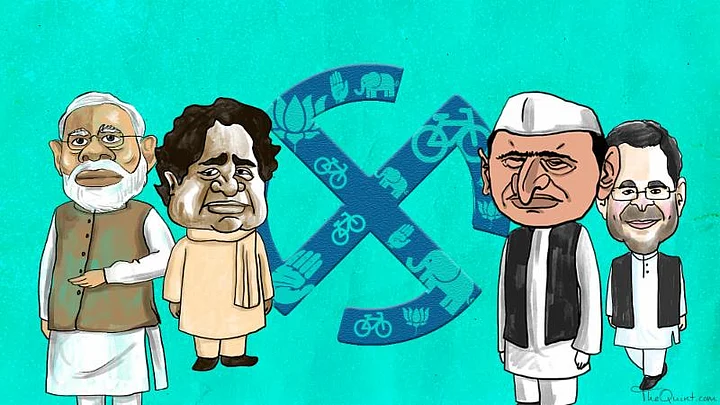It has been quite an experience, for more than one reason, to read reports and columns by veteran journalists, calling the Uttar Pradesh Assembly elections in favour of the Bharatiya Janata Party (BJP). One such column appeared in the Hindustan Times on Friday.
The arguments are mostly the same – the BJP has stitched together a broad, and seemingly invincible, coalition of upper castes, extreme backward classes and non-Jatav Dalits. These journalists argue that sheer numbers have placed the BJP at pole position.
The argument is that even if the BJP’s vote share drops by a staggering 10 percent, compared to the 2014 Lok Sabha elections, it will still have enough votes to get an absolute majority in the 403-member UP assembly.
Different Voting Patters for Assembly and General Elections
Do we need to remind seasoned opinion makers that people vote differently, and for different issues, in the Lok Sabha and the Assembly elections?
In 2012, the BJP managed to win only 15 percent of the popular vote, with the Samajwadi Party (SP) bagging 29.13 percent – which was sufficient to propel it to power on the basis of the first-past-the-post principle. Meanwhile, the Bahujan Samaj Party (BSP) won 25.91 percent.
The data suggests that in 2012, the polity was fragmented. Travels across western UP (where elections have already been held) and eastern UP (where polling is scheduled for 4 and 8 March) indicate that voters were, and remain, unsure about which party to vote for – some of the responses may be attributed to hedging, or even a polite refusal to disclose preference.
Are there no state-level issues that will play on voters’ minds before they cast their ballots?
UP’s voters have much to think about: the baby steps that Akhilesh Yadav’s government has taken on the development (vikas) front; the SP’s patronage politics, that makes a difference in the lives of people living on the margins; a young CM candidate, who appears to have successfully weathered the storm within his own party, to emerge a “powerful” leader, and his promise to rid the state of gunda raj; not to mention the ubiquitous caste (read Yadav) politics, in which the SP is a champion player.
While much has been said and written about the SP-Congress alliance and its fortunes, the BSP is no bit player. It enjoys substantial support among the Dalit community, especially the Jatavs, across all districts of UP.
The Mayawati-led party has certainly been hit by demonetisation, but in western UP, it could well end up with the bulk of the seats in its kitty.
BJP Solely Relying on Modi’s Charisma in UP
The rational voter will also consider what the BJP has to offer, save for its intermittent deployment of shrill and subtle Hindutva rhetoric, bordering on the communal.
Like elsewhere in the past, especially Bihar, the BJP has relied on the personal popularity of Narendra Modi to try and win UP. The party doesn’t have a credible state-level leader to project as its chief ministerial candidate.
Besides, the BJP’s campaign is devoid of the development word, with even a desperate Modi and many others taking all opportunities to give vent to not-so-subtle communal rhetoric. A bigger problem for the BJP, however, is that in district after district, the party is faced with internal dissension, characterised by dissatisfaction over ticket distribution.
Seven-time BJP MLA Shyamdeb Roychowdhury’s anger with his party speaks for itself.
Commentators have been liberally making sweeping statements on how a broad coalition of upper castes, extreme backward classes (EBCs) and non-Jatav Dalit “aspirations” are coming together in favour of the BJP.
The BJP tried to have more of the same in Bihar and failed. And the party has been trying to, without much success, forge such a dream coalition in UP for more than two decades now. The group of EBCs consists of a multitude of castes with varying aspirations. Similarly, the non-Jatav Dalits group is not a monolith.
Do sweeping generalisations take these differences into consideration?
Predictions make for interesting reading when backed by some numbers and empirical evidence – the number of people spoken to from such broad caste groups, for instance. What has been predicted may well turn out to be true.
But by making such sweeping statements, with a view to create a “favourable” perception for a party to the detriment of others, has an attempt been made to set a new precedent in journalism?
Post script: One newspaper column used wrong data on the BJP’s vote in the 2015 Bihar assembly elections. In Bihar, the BJP’s vote share was not 34 percent, but merely 24.42 percent. Social science research methods tell us that data, especially quantitative data, must not only be reliable but also valid.
(At The Quint, we question everything. Play an active role in shaping our journalism by becoming a member today.)
